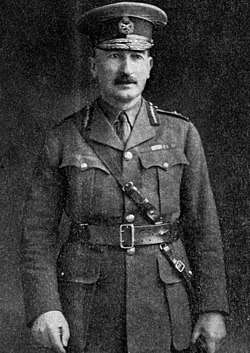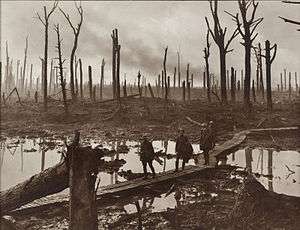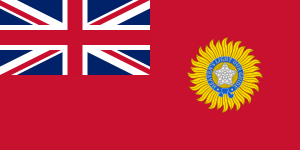Claud Jacob
Field Marshal Sir Claud William Jacob, GCB, GCSI, KCMG (21 November 1863 – 2 June 1948) was a British Indian Army officer. He served in the First World War as commander of the Dehra Dun Brigade, as General Officer Commanding 21st Division and as General Officer Commanding II Corps in the Fifth Army. During the Battle of the Somme, his corps undertook the British attack during the Battle of Thiepval Ridge in September 1916 and the subsequent assault on St Pierre Divion during the Battle of the Ancre in November 1916. He remained in command of II Corps for the Battle of Passchendaele in Autumn 1917. After the War he commanded a corps of the British Army of the Rhine during the occupation there and then served as Chief of the General Staff in India. He went on to be General Officer Commanding Northern Command in India before temporarily becoming Commander-in-Chief, India and then taking over as Military Secretary to the India Office.
Sir Claud William Jacob | |
|---|---|
 Lieutenant General Claud Jacob c. 1916 | |
| Born | 21 November 1863 Mahidpur, British India |
| Died | 2 June 1948 (aged 84) |
| Service/ | Indian Army |
| Years of service | 1882–1925 |
| Rank | Field Marshal |
| Commands held | Commander-in-Chief, India Northern Command, India Chief of the General Staff (India) II Corps 21st Division 106th Hazara Pioneers Zhob Levy Corps |
| Battles/wars | North-West Frontier First World War |
| Awards | Knight Grand Cross of the Order of the Bath Knight Grand Commander of the Order of the Star of India Knight Commander of the Order of St Michael and St George |
| Relations | Lieutenant General Sir Ian Jacob (son) |
Military career
Jacob was born on 21 November 1863, at Mahidpur in the Bombay Presidency of British India, to Major-General William Jacob and Eliza Jacob.[1]
Educated at Sherborne School, he passed into Sandhurst and was commissioned into the Worcestershire Regiment on 9 September 1882.[2] On 16 December 1884, stationed at Quetta, he secured his transfer from the Worcestershire Regiment[3] to the Indian service[4] and, in July 1886, he became adjutant of the 30th Regiment (Jacob’s) Bombay Native Infantry also known as 3rd Belooch Regiment (now 12 Baloch).[5] He first saw action with the Zhob Valley expedition of 1890 after which he was posted to the 24th (Baluchistan) Regiment of Bombay Infantry (now 6 Baloch) in 1891.[5] Promoted to captain on 9 September 1893[6] and to major on 10 July 1901,[7] he was selected to command the Zhob Levy Corps, which kept the peace in the North West Frontier Province along the Waziristan and Southern Afghanistan border.[5] He took part in the blockade of the Mahsud Waziri tribe at the end of 1901.[1] Promoted to lieutenant-colonel on 1 October 1904,[8] he was given command of the 106th Hazara Pioneers.[5] Promoted to brevet colonel on 1 October 1908[9] and to full colonel on 1 January 1911,[10] he was appointed GSO1 of the Meerut Division on 2 September 1912.[11]
At the outbreak of the First World War in 1914, Jacob went with the Meerut division, part of the Indian corps, to the Western Front.[5] He saw action at the closing stages of the Battle of La Bassée in October 1914.[5] Promoted to temporary brigadier-general on 5 January 1915, he was appointed to command the Dehra Dun Brigade,[12] and led the brigade at the Battle of Neuve Chapelle in March 1915 and the Battle of Aubers Ridge in May 1915.[5] Promoted to temporary major-general on 7 September 1915,[13] he became General Officer Commanding the Meerut division and led the division at the Battle of Loos in October 1915.[5] With the Indian Corps was preparing to leave the Western front, he was appointed to take over the 21st Division of the "New Armies" on 18 November 1915.[5] Promoted to the substantive rank of major-general on 1 January 1916[14] and despite being wounded in March 1916,[15] he was promoted to temporary lieutenant-general on 28 May 1916[16] and appointed to command II Corps in the Fifth Army in September 1916.[15] During the Battle of the Somme, his corps undertook the British attack during the Battle of Thiepval Ridge in September 1916 and the subsequent assault on St Pierre Divion during the Battle of the Ancre in November 1916.[1] He remained in command of II Corps, having been promoted to the substantive rank of lieutenant-general on 3 June 1917,[17] for the Battle of Passchendaele in Autumn 1917.[15]
Jacob commanded a corps of the British Army of the Rhine during the occupation there.[15] He became Chief of the General Staff in India in January 1920 and was then both promoted to full general[18] and appointed Aide-de-Camp to King George V on 31 May 1920.[19] He returned home to England in 1924, and in November of that year was given the Northern Command in India.[15] When Lord Rawlinson died in March 1925, he acted temporarily as Commander-in-Chief, India,[20] until Sir William Birdwood took over that role in August 1925 and Jacob returned home again.[21] He took up the appointment of Military Secretary to the India Office in April 1926[22] and, having been promoted field marshal on 30 November 1926,[23] he remained at the India Office until he retired in May 1930.[24]
In retirement Jacob became Constable of the Tower of London.[25] He was also Colonel of 2nd Battalion The Baluch Regiment (now 7th Battalion The Baloch Regiment),[26] Colonel of the 106th Hazara Pioneers[27] and Colonel of the Worcestershire Regiment.[28] In January 1936 he attended the funeral of King George V[29] and in May 1937 he attended the coronation of King George VI.[30] He died at King's College Hospital in London on 2 June 1948 at the age of eighty-four.[15]
Family

In 1894, he married Clara Pauline Wyatt, daughter of the Reverend J. L. Wyatt, well known as a missionary and student of oriental languages in India, and also a lecturer in Tamil at Cambridge University from 1895 to 1929. The couple had one son, Edward Ian Claud Jacob, who later became Assistant Military Secretary of the War Cabinet and Director-General of the BBC.[31]
Honours
British
- KCMG – 1 January 1919[32]
- GCSI – 3 June 1930[33] (KCSI – 1 January 1924[34])
- GCB – 3 July 1926[35] (KCB – 1917; CB – 1915)[15]
- Knight of Grace of the Venerable Order of Saint John – 19 June 1926[36]
Foreign
- Grand Officer of the Order of the Crown (Belgium) – 11 March 1918[37]
- Grand Officer of the Legion of Honour (France) – 15 December 1919[38]
- Croix de guerre (France) – 7 January 1919[39]
- Distinguished Service Medal (United States) – 12 July 1919[40]
References
- "Sir Claud Jacob". Oxford Dictionary of National Biography. Retrieved 25 May 2013.
- "No. 25145". The London Gazette. 8 September 1882. p. 4178.
- "No. 25440". The London Gazette. 10 February 1885. p. 576.
- "No. 25568". The London Gazette. 16 March 1886. p. 1284.
- Heathcote, p. 190
- "No. 26458". The London Gazette. 14 November 1893. p. 6357.
- "No. 27362". The London Gazette. 4 October 1901. p. 6487.
- "No. 27751". The London Gazette. 6 January 1905. p. 151.
- "No. 28247". The London Gazette. 4 May 1909. p. 3389.
- "No. 28487". The London Gazette. 21 April 1911. p. 3095.
- "No. 28657". The London Gazette. 25 October 1912. p. 7869.
- "No. 29075". The London Gazette (Supplement). 16 February 1915. p. 1710.
- "No. 29319". The London Gazette (Supplement). 5 October 1915. p. 9871.
- "No. 29438". The London Gazette (Supplement). 11 January 1916. p. 568.
- Heathcote, p. 191
- "No. 29633". The London Gazette (Supplement). 20 June 1916. p. 6193.
- "No. 30111". The London Gazette (Supplement). 1 June 1917. p. 5463.
- "No. 32185". The London Gazette (Supplement). 14 December 1920. p. 12384.
- "No. 32185". The London Gazette. 7 January 1921. p. 186.
- "No. 33037". The London Gazette. 10 April 1925. p. 2469.
- "No. 33081". The London Gazette. 4 September 1925. p. 5841.
- "No. 33189". The London Gazette. 6 August 1926. p. 5206.
- "No. 33225". The London Gazette. 30 November 1926. p. 7814.
- "No. 33613". The London Gazette. 6 June 1930. p. 3572.
- "No. 34495". The London Gazette. 22 March 1938. p. 1936.
- "No. 33447". The London Gazette (Supplement). 14 December 1928. p. 8255.
- "No. 29651". The London Gazette. 4 July 1916. p. 6613.
- "No. 33265". The London Gazette. 12 April 1927. p. 2408.
- "No. 34279". The London Gazette (Supplement). 29 April 1936. p. 2763.
- "No. 34453". The London Gazette (Supplement). 10 November 1937. p. 7035.
- Miall, p. 91–101
- "No. 31092". The London Gazette (Supplement). 31 December 1918. p. 3.
- "No. 33611". The London Gazette (Supplement). 30 May 1930. p. 3476.
- "No. 32893". The London Gazette (Supplement). 28 December 1923. p. 4.
- "No. 33179". The London Gazette (Supplement). 2 July 1926. p. 4403.
- "No. 33174". The London Gazette. 22 June 1926. p. 4037.
- "No. 30568". The London Gazette (Supplement). 8 March 1918. p. 3094.
- "No. 31688". The London Gazette (Supplement). 12 December 1919. p. 15577.
- "No. 31109". The London Gazette (Supplement). 3 January 1919. p. 313.
- "No. 31451". The London Gazette (Supplement). 11 July 1919. p. 8938.
Sources
- Heathcote, Tony (1999). The British Field Marshals 1736–1997. Barnsley (UK): Pen & Sword. ISBN 0-85052-696-5.
- Miall, Leonard (1994). Inside the BBC: British Broadcasting Characters. Weidenfeld and Nicolson. ISBN 0-297-81328-5.
External links
| Military offices | ||
|---|---|---|
| Preceded by George Forestier-Walker |
General Officer Commanding 21st Division 1915–1916 |
Succeeded by David Campbell |
| Preceded by Charles Fergusson |
GOC II Corps September 1916 – September 1919 |
Succeeded by Sir Alexander Godley |
| Preceded by Sir George Kirkpatrick |
Chief of the General Staff (India) 1920–1924 |
Succeeded by Sir Andrew Skeen |
| Preceded by Sir William Birdwood |
GOC-in-C, Northern Command, India 1924–1925 |
Succeeded by Sir Alexander Cobbe |
| Preceded by Henry Rawlinson |
Commander-in-Chief, India 1925 |
Succeeded by William Birdwood |
| Preceded by Sir Alexander Cobbe |
Military Secretary to the India Office 1926–1930 |
Succeeded by Sir Alexander Cobbe |
| Honorary titles | ||
| Preceded by Baron Milne |
Constable of the Tower of London 1943–1948 |
Succeeded by Baron Chetwode |
.svg.png)
